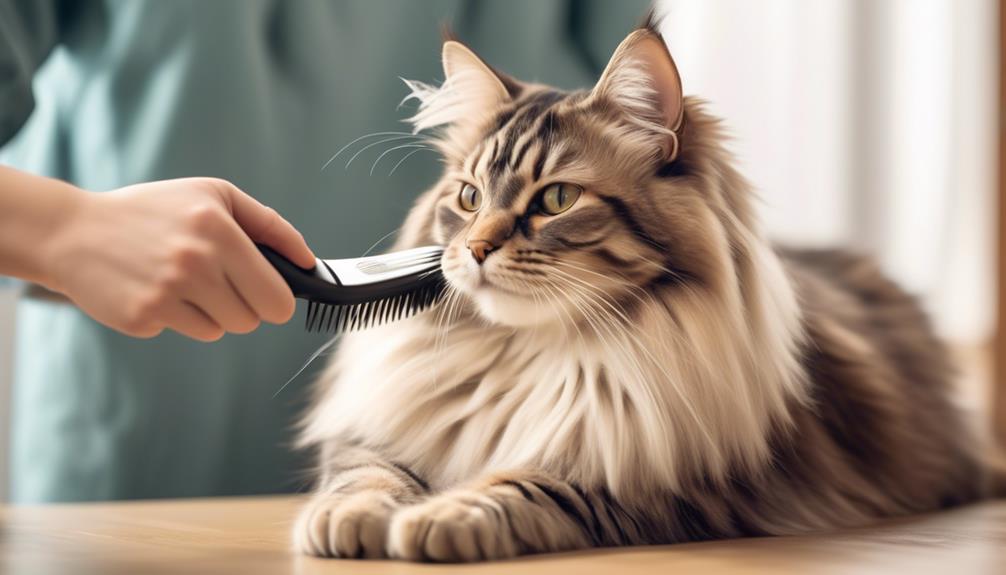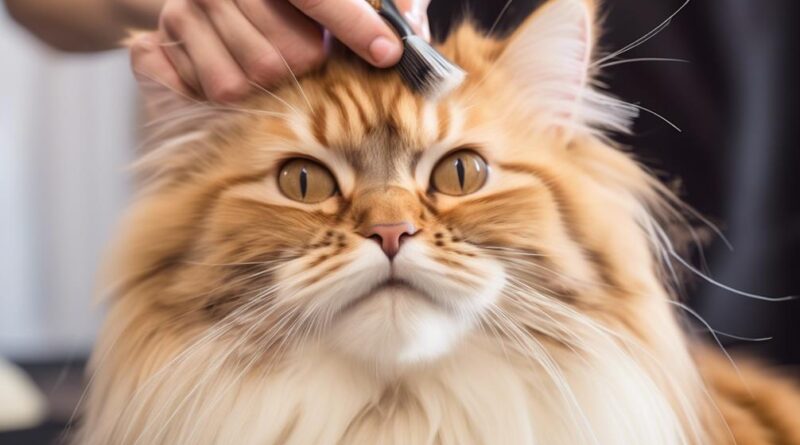9 Best Grooming Tips for Long-Haired Cats at Home
If you want to keep your long-haired cat looking and feeling their best, you'll need to master the art of grooming. Brushing, bathing, mat prevention – these are just a few of the essential tasks that will keep your feline friend's coat healthy and beautiful.
But fear not, with the right techniques and a little patience, you can easily tackle these grooming tasks at home. So, are you ready to discover the secrets to maintaining your long-haired cat's luxurious coat and overall well-being?
Brushing Techniques
To keep your long-haired cat's coat healthy and tangle-free, regularly brush them using a gentle but firm motion to remove loose fur and prevent matting. Proper technique is essential when brushing a long-haired cat. Use a stainless steel comb or a slicker brush to penetrate the thick fur and reach the skin, ensuring you don't miss any tangles or mats. Start by brushing in the direction of hair growth, then against it to catch any loose fur or tangles. This method helps to prevent tangles from forming and keeps your cat's coat smooth and shiny.
The frequency of brushing is also crucial. For long-haired cats, it's recommended to brush them at least once a day to prevent mats and tangles from forming. However, during shedding season, you may need to brush them more frequently to remove excess fur and prevent it from matting. Grooming tools such as a wide-toothed comb or an undercoat rake can be particularly useful during shedding season to remove loose undercoat fur effectively.
When it comes to detangling methods, patience is key. If you encounter a mat or tangle, use a detangling spray or a small amount of conditioner to help loosen the fur. Gently work through the mat with your fingers or a mat splitter, starting from the outer edges and working your way inwards. Avoid pulling or yanking on the mat, as this can cause discomfort to your cat.
With regular brushing using the proper techniques and grooming tools, you can help keep your long-haired cat's coat smooth, healthy, and free of tangles.
Bathing Tips
Keeping your long-haired cat's coat smooth and healthy requires proper bathing techniques to complement regular brushing and grooming. When it comes to bathing your long-haired feline friend, there are a few key tips to keep in mind to ensure a successful and stress-free experience for both you and your cat.
- Shampoo Selection and Application
- Choose a mild cat-specific shampoo to avoid skin irritation and maintain the natural oils in your cat's coat.
- Dilute the shampoo with water as per the instructions on the bottle before gently massaging it into your cat's fur. This helps in achieving an even application and prevents overuse of the product.
- Drying Methods and Frequency
- After the bath, carefully wrap your cat in a towel to absorb excess water. Use a soft, absorbent towel to gently pat and blot the fur, avoiding any vigorous rubbing that could cause tangling.
- If your long-haired cat tolerates it, you can use a low-heat setting on a pet-specific hair dryer to ensure their coat is thoroughly dried. However, always ensure the dryer is held at a safe distance to prevent discomfort or burns.
Mat Prevention
Regular brushing is crucial for preventing mats in your long-haired cat's fur. By brushing your cat's coat at least a few times a week, you can effectively minimize tangles and control shedding. When brushing, focus on removing any tangles or knots that have formed in your cat's fur. Use a metal comb or a de-matting tool to gently work through the tangles, starting at the tips of the fur and working your way up to the skin. This will help prevent mats from forming and keep your cat's coat smooth and healthy.
In addition to regular brushing, shedding control is also essential for mat prevention in long-haired cats. Cats naturally shed their fur, and if left unchecked, this can contribute to mat formation. To help control shedding, consider using a de-shedding tool specifically designed for long-haired cats. These tools can help remove loose fur from your cat's coat, reducing the amount of hair that can become tangled and matted.
Furthermore, paying attention to your cat's grooming habits can also aid in mat prevention. Cats that have difficulty grooming themselves due to age or other factors may require more frequent brushing to prevent mats from forming. Keeping an eye on your cat's coat and addressing any tangles or matting as soon as you notice them will help maintain your cat's long fur in good condition.
Trimming Nails
One important aspect of grooming your long-haired cat at home is trimming their nails to maintain their overall health and well-being. Nail clipping is essential for your cat's paw care, and it's important to do it properly to avoid causing them any discomfort. Here are some tips to help you with this important grooming task:
- Use the Right Tools
Invest in a good pair of cat nail clippers. Human nail clippers can cause the nails to splinter, so it's best to use clippers specifically designed for cats.
- Technique is Key
Hold your cat securely but gently, and only trim the very tip of each nail. Be mindful of the quick, the sensitive part of the nail that contains blood vessels and nerves. Cutting into the quick can be painful and may cause bleeding.
Trimming your long-haired cat's nails isn't only beneficial for their health but also for your home. Regular nail clipping prevents your cat from snagging their claws on carpeting and furniture, reducing the likelihood of damage to your belongings. Additionally, keeping their nails trimmed can minimize the risk of accidental scratches to you and your family members.
Ear Cleaning
To maintain your long-haired cat's overall health and well-being, it's important to regularly clean their ears with gentle care and attention. Ear hygiene is crucial for preventing infections and other ear-related issues. When it comes to ear cleaning, it's essential to have the right grooming tools on hand. Look for a gentle ear cleaner specifically designed for cats, along with some cotton balls or pads.
Before starting the ear cleaning process, it's important to conduct a thorough ear inspection. Check for any signs of redness, swelling, or unusual discharge, as these could indicate an underlying problem that requires veterinary attention.
To begin the ear cleaning process, apply a small amount of the ear cleaner onto a cotton ball or pad. Gently hold your cat's head to prevent sudden movements, and carefully wipe the visible parts of the ear, avoiding the ear canal. Never insert anything deep into the ear canal, as this can cause damage and discomfort to your cat.
If you notice excessive wax buildup or dirt within the ear canal, it's best to leave the ear canal cleaning to a professional groomer or veterinarian. Regular ear inspections and cleanings can help keep your long-haired cat's ears healthy and free from potential issues, contributing to their overall well-being.
Dental Care
Maintain your long-haired cat's dental health by regularly brushing their teeth with a feline-specific toothbrush and toothpaste. Feline oral hygiene is essential for preventing dental issues such as plaque buildup and gum disease. To ensure that your cat's teeth stay clean and healthy, here are some essential tooth brushing techniques to keep in mind:
- Introduce the Toothbrush Gradually
- Start by letting your cat sniff and lick the toothbrush to familiarize them with it.
- Gradually introduce the toothbrush by gently rubbing it along their gums and teeth without toothpaste.
- Use Feline-Specific Toothpaste
- Never use human toothpaste as it can be harmful to cats.
- Choose a feline-specific toothpaste in a flavor your cat enjoys, such as poultry or seafood, to make the experience more pleasant for them.
Coat Maintenance

Regularly grooming your long-haired cat's coat is essential for preventing tangles and matting. Shedding control is a crucial aspect of coat maintenance for long-haired cats. To keep shedding under control, it's important to brush your cat's coat at least a few times a week. Use a high-quality brush designed for long-haired cats to gently remove loose fur and prevent it from matting with the healthy coat. Additionally, regular brushing helps distribute natural oils throughout the fur, keeping it healthy and shiny.
When it comes to hair detangling, using the right tools and techniques is key. Look for a specialized detangling comb or brush to gently work through any knots or tangles in your cat's fur. Start by carefully working through small sections of fur, using short, gentle strokes to avoid causing discomfort to your cat. If you encounter stubborn tangles, be patient and work through them slowly and delicately. It's important to address tangles promptly to prevent them from turning into mats, which can be uncomfortable for your cat and may require professional grooming to remove.
Incorporating these shedding control and hair detangling practices into your regular grooming routine will help maintain your long-haired cat's coat in optimal condition, preventing discomfort and ensuring your feline friend looks and feels their best.
Handling Shedding
As you groom your long-haired cat's coat to prevent tangles and matting, managing shedding is a crucial aspect of their care. Shedding is a natural process for long-haired cats, but with the right grooming techniques, you can keep it under control and maintain your cat's beautiful coat.
- Grooming Frequency
Regular grooming sessions are essential to keep shedding in check. Aim for brushing your long-haired cat at least 2-3 times a week to remove loose fur and prevent it from matting or forming hairballs. This not only reduces shedding around your home but also promotes a healthy coat and skin for your cat.
- Shedding Control
Invest in a high-quality de-shedding tool specifically designed for long-haired cats. These tools are effective at removing loose fur from the undercoat, where shedding is most prevalent. Additionally, consider using grooming wipes or a damp cloth to gently remove loose fur from your cat's coat between brushing sessions.
Frequently Asked Questions
How Can I Minimize Hairballs in My Long-Haired Cat?
To minimize hairballs in your long-haired cat, try dietary changes and regular grooming. Incorporate omega-3 fatty acids into their diet. Brush your cat often to reduce shedding and prevent hairballs. Keep them well-groomed for a healthier coat.
What Are Some Tips for Detangling Mats in My Cat's Fur?
To prevent mats in your cat's fur, daily maintenance is key. Regular brushing and combing help prevent tangles. If mats do form, use a detangling spray and a wide-tooth comb to gently work them out.
Are There Any Specific Grooming Tools or Products That Are Best for Long-Haired Cats?
You should consider the best grooming tools and recommended grooming products to keep your long-haired cat's coat healthy. Regular brushing with a good quality slicker brush and using a cat-specific detangling spray can help manage their fur.
How Often Should I Take My Long-Haired Cat to a Professional Groomer?
You should take your long-haired cat to a professional groomer every 4-6 weeks to maintain their coat's health. At home, groom your cat regularly to control shedding. Professional groomers have the expertise to handle more extensive grooming needs.
What Are Some Signs That My Long-Haired Cat May Need to See a Veterinarian for Grooming-Related Issues?
If your long-haired cat's grooming frequency changes or you notice skin irritation, matting, or excessive shedding, it may indicate health implications. A veterinarian should be consulted for grooming-related issues to ensure your cat's well-being.
Conclusion
Now that you have the grooming tips for long-haired cats, you can keep your feline friend looking and feeling their best at home.
Regular brushing, bathing, nail trimming, and ear cleaning will help prevent mats and keep your cat comfortable.
Remember to also maintain their dental care and handle shedding to keep their coat healthy.
With these tips, you can easily maintain your long-haired cat's grooming routine at home.
